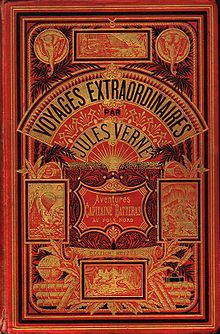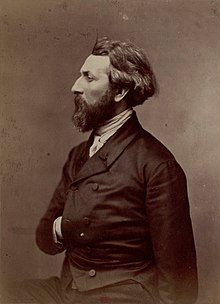Pierre-Jules Hetzel

Pierre-Jules Hetzel (born January 15, 1814 in Chartres , Eure-et-Loir , † March 17, 1886 in Monte-Carlo ) was a French author and publisher . He is particularly known for the richly illustrated editions of Jules Verne's novels, which today fetch very high prices from collectors. Hetzel was also the main publisher of Victor Hugo and other French writers.
Career
After dropping out of his law studies in Strasbourg , Hetzel founded a publishing house in 1837. He was the editor of the works of Honoré de Balzac , whose Comédie humaine appeared in 1841, and also published the works of Victor Hugo and Émile Zola . In 1843 he founded the magazine Nouveau magasin des enfants . Hetzel was known as a republican and in 1848 became head of the cabinet of then Foreign Minister Alphonse de Lamartine . After the coup d'état that ended the Second French Republic , he went into exile in Belgium, where he continued his political and literary activities against the Second Empire. He did this through the secret publication of Victor Hugo's pamphlet Les Châtiments .
In 1859 Hetzel returned to France and published works by Proudhon and Baudelaire . An important edition of the stories by Charles Perrault , illustrated by Gustave Doré , was also produced during this period. He founded the Bibliothèque illustrée des Familles , which was renamed Magasin d'éducation et de récréation in 1864 . His goal was for scientists, writers and illustrators to work together to produce visual publications for the whole family.
Collaboration with Jules Verne
Hetzel's fame came from the editions of the Voyages extraordinaires ("Incredible Voyages") by Jules Verne, which he edited . The stories were originally published as sequel stories in biweekly chapters. Only when all the chapters of a story had appeared was it offered in book form. This was usually the case at the end of the year, so that the books could be used as Christmas gifts for older children. There were 3 versions each: an inexpensive version without illustrations, a small-format edition with a few and a third, large edition with many illustrations. The books of the last-mentioned editions are very popular with book collectors today.
It is generally accepted that Hetzel discovered the writer Jules Verne, but experts disagree on whether it was Hetzel who made Verne a success, or whether it was the literary success of Verne who helped the publisher Hetzel to break through. Each benefited from the other, and their relationship evidently went far beyond that of writer and publisher.
In 1863, Hetzel rejected Verne's manuscript for Paris in the 20th century because he believed it would paint a vision of the future that would be too negative and unbelievable for contemporary audiences. However, scientists later discover that Verne's predictions came true with astonishing accuracy. Verne closed the draft and later did not write any more dystopian stories. Paris in the 20th Century wasn't published in France until 1994.
Hetzel wrote under the pseudonym P.-J. Stahl also books for young people. After his death, the publishing company was run by his son and, from 1914, by Hachette Livre .
Web links
- Information about Hetzel at www.j-verne.de
- Les Cartonages Hetzel . Information on Hetzel's book editions of Jules Verne books (French)
- Pierre-Jules Hetzel and Elisée Reclus (Italian)
- Hetzel and Verne: Cooperation and Conflict (English)
| personal data | |
|---|---|
| SURNAME | Hetzel, Pierre-Jules |
| ALTERNATIVE NAMES | P.-J. Steel (pseudonym) |
| BRIEF DESCRIPTION | French author and publisher |
| DATE OF BIRTH | January 15, 1814 |
| PLACE OF BIRTH | Chartres , Eure-et-Loir , France |
| DATE OF DEATH | March 17, 1886 |
| Place of death | Monte Carlo |
